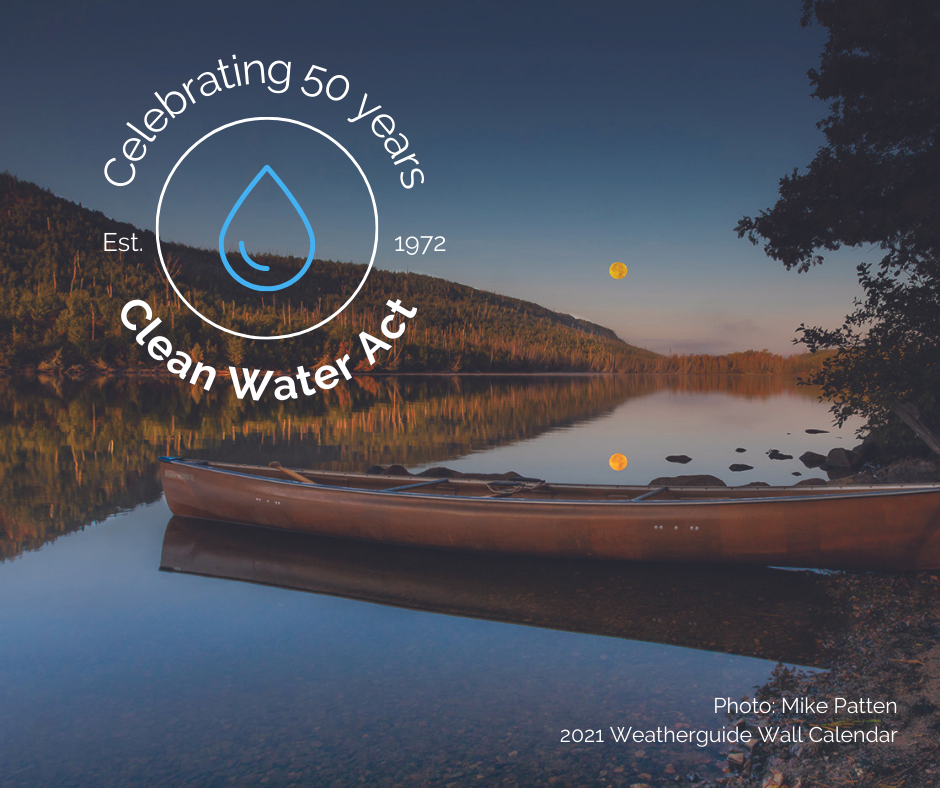
Before 1972, water – and the life that depends on it—was in peril. Many lakes, rivers, and wetlands in the United States were suffering from uncontrolled pollution and neglect. The control of sewage and industrial waste discharges were left to the devices of individual communities, states or businesses. Most were inadequate to protect water quality, and it was not unusual to see sewage and industrial waste dumped directly into nearby rivers. In fact, hard as it is for us to imagine now, that was the norm. These were the conditions that led to such events as the burning of the Cuyahoga River, and while the fire didn’t happen everywhere, it was clear that this was a national problem that needed national action.
The Clean Water Act established in 1972 was the first monumental step toward protecting the waterbodies that are so essential to all life. The Clean Water Act created a formal structure for regulating pollutant discharges to water, establishing water quality standards that aimed at protecting and restoring fishable and swimmable waters standards. The Act, along with the largest-ever federal investment in upgrading community sewage treatment, has led to dramatically improved conditions in fresh water across the nation.
Minnesota has gone beyond the initial success of the Clean Water Act and is making progress by protecting and restoring freshwater resources from unregulated, non-point pollution. In 2008, Minnesotans overwhelmingly supported the Clean Water, Land, and Legacy Amendment, voting to increase their own sales tax to protect clean water, preserve outdoor heritage and support the arts. This created a special fund dedicated to protecting and restoring Minnesota’s waters, going beyond the initial success of the Clean Water Act to support local communities in addressing unregulated, non-point pollution. Since the passage of the Legacy Amendment, more than $1 billion has been invested from the Clean Water Fund, making Minnesota the envy of states without this dedicated funding source because now we better understand the issues and opportunities, and have a fund that can help us take action. So far, we can point to the following achievements:
- Minnesota’s approach to clean water set up a systematic approach to supporting local action
- All major watersheds in Minnesota have now been assessed
- Most of those watersheds now have plans based on that data
- Completed plans are now being followed, putting the money to targeted uses to help get the biggest bang for the buck
- While the list of impaired waters grows as a result of choosing to study them, we’re also making progress—water quality has been restored in more than 50 lakes and streams, and more are on the way
- Over 1,200 producers managing 920,000 acres have been Water Quality Certified
- Drinking water is being better understood and protected as well
- State agencies are working with staff managing municipal water systems in vulnerable areas to protect their source water
- More than 30,000 private wells in 50 counties have voluntarily been tested for nitrate, helping individuals make decisions to protect their health
- We’re using less water—per person water use went down 20% between 2012 and 2020 alone
- We’ve dramatically increased funding for local action—from July 2010 to June 2019, this special fund attracted 95 cents of additional funding for every dollar spent, essentially doubling the money available for these clean water projects and programs
While we have come a long way since 1972 and many of our waterways have improved, we know that there is still more work to be done, and we cannot rest on our laurels. Freshwater’s policy focus includes protecting constitutionally dedicated sources of funding like the Clean Water Fund, which has only become more important as general funding for water and the environment has eroded over time. We know that systems level approaches are needed to get us to a clean water future.
We also know that every one of us has a role to play. Everything that happens on land impacts water, and the land and water alterations from the last 150 years got us to where we are today. We must actively combat the effects of everyday pollution. We are facing new and different pollution problems such as chloride pollution from road salt use as well as plastic and other trash pollution. Freshwater’s education programs aim to empower and inspire people and communities to take action for water. If you’re looking for a way to express gratitude for the improvements of the last 50 years or double down on securing that clean water future, these Freshwater programs may be right for you:
- Become a Minnesota Water Steward. Recruitment is open now for the 2023 class of Stewards. Learn about water issues in your area, build skills to take action, gain certification, and add your efforts to the growing impact of these super volunteers.
- Add your individual drop to a watershed of action—host an Adopt a River cleanup. Fall is a perfect time and anyone can do it from anywhere—enjoy the beautiful colors and keep trash from entering our waterways before the snow locks it in for the winter.
- Join the ranks of members supporting Freshwater—Freshwater is a member-supported organization and October is member month! You can become a monthly donor for as little as $5 a month, or give a one-time or recurring annual gift, knowing that every dollar raised supports Freshwater in being a nimble and resilient organization
Thank you to all of you for all you do to care for Minnesota’s waters,
John Linc Stine
Beautifully written. A fine blend of positives as well as a cautionary note … The concluding list of to-dos leaves no one untouched by actions that are inclusive and possible.
Blessings and peace and gratitude,
Anna 🐝